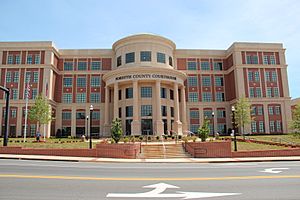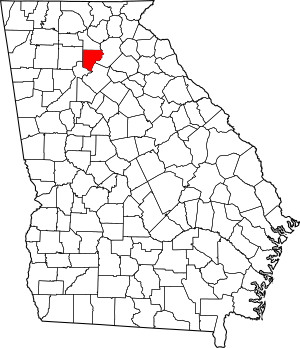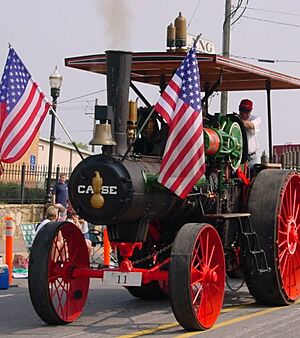Forsyth County, Georgia facts for kids
Quick facts for kids
Forsyth County
|
||
|---|---|---|

Forsyth County Courthouse in Cumming
|
||
|
||

Location within the U.S. state of Georgia
|
||
 Georgia's location within the U.S. |
||
| Country | ||
| State | ||
| Founded | December 3, 1831 | |
| Named for | John Forsyth | |
| Seat | Cumming | |
| Largest city | Big Creek CCD | |
| Area | ||
| • Total | 247 sq mi (640 km2) | |
| • Land | 224 sq mi (580 km2) | |
| • Water | 23 sq mi (60 km2) 9.4%% | |
| Population
(2020)
|
||
| • Total | 251,283 | |
| • Estimate
(2023)
|
272,887 |
|
| • Density | 1,017.3/sq mi (392.8/km2) | |
| Time zone | UTC−5 (Eastern) | |
| • Summer (DST) | UTC−4 (EDT) | |
| ZIP Codes |
30024, 30040, 30041, 30004, 30506, 30005, 30028
|
|
| Congressional district | 6th | |
Forsyth County is a county in the U.S. state of Georgia. It's located in the Northeast part of the state, close to the big city of Atlanta and the beautiful Blue Ridge Mountains. Many people who live here work in the Atlanta area.
The county's only official city and main town is Cumming. In 2020, about 251,283 people lived in Forsyth County. It was the fastest-growing county in Georgia between 2010 and 2019! This is because many people move here for good jobs nearby, nice new homes, and especially for the excellent public schools. The average family income in Forsyth County is high, making it one of the wealthiest counties in Georgia.
In the 1980s, Forsyth County was in the news because of large protests for civil rights. Thousands of people marched to protest unfair treatment and segregation. Police and the National Guard helped keep the peace during these events. These protests aimed to show that the county was working towards being fair and welcoming to everyone.
Contents
History of Forsyth County
For thousands of years, different groups of Native Americans lived in this area. Around 1,000 years ago, people known as "Mound Builders" lived here. They built large earth mounds, like those found at Etowah Indian Mounds in a nearby county. These groups disappeared around 1500 CE.
Later, the Cherokee Nation moved into this area from the North. They settled throughout upper Georgia and other nearby states.
In 1829, gold was discovered in the area. This brought many European settlers who wanted the land. The Cherokee people were sadly forced to leave their homes and move west of the Mississippi River. This difficult journey is known as the Trail of Tears.
Forsyth County was officially created in 1831. It was named after John Forsyth. He was the Governor of Georgia and later a top government official for the United States. For many years, the county was mostly farmland.
Geography and Nature
Forsyth County covers about 247 square miles. About 224 square miles is land, and 23 square miles (which is about 9.4%) is water.
The county has two main river systems. The eastern part is in the Chattahoochee River area, and the northwestern part is in the Etowah River area.
Main Roads in Forsyth County
Many important roads run through Forsyth County, helping people travel around.
Neighboring Counties
Forsyth County shares its borders with several other counties:
- Dawson County (to the north)
- Hall County (to the east)
- Gwinnett County (to the southeast)
- Fulton County (to the southwest)
- Cherokee County (to the northwest)
Protected Natural Areas
Part of the Chattahoochee River National Recreation Area is located in Forsyth County. This area helps protect the river and its natural beauty.
Communities in Forsyth County
The City of Cumming
- Cumming is the only official city in Forsyth County. It is also the county seat, meaning it's where the county government is located.
Other Communities
Many people in Forsyth County live in areas that are not officially part of a city. These are called "unincorporated communities." Some of these areas share zip codes with cities in other counties.
There are also several other unincorporated communities within the county:
- Brookwood
- Coal Mountain
- Chestatee
- Silver City
- Daves Creek
- Friendship
- Oscarville
- Big Creek
- Matt
- Ducktown
People of Forsyth County
| Historical population | |||
|---|---|---|---|
| Census | Pop. | %± | |
| 1840 | 6,619 | — | |
| 1850 | 8,850 | 33.7% | |
| 1860 | 7,749 | −12.4% | |
| 1870 | 7,983 | 3.0% | |
| 1880 | 10,559 | 32.3% | |
| 1890 | 11,155 | 5.6% | |
| 1900 | 11,550 | 3.5% | |
| 1910 | 11,940 | 3.4% | |
| 1920 | 11,755 | −1.5% | |
| 1930 | 10,624 | −9.6% | |
| 1940 | 11,322 | 6.6% | |
| 1950 | 11,005 | −2.8% | |
| 1960 | 12,170 | 10.6% | |
| 1970 | 16,928 | 39.1% | |
| 1980 | 27,958 | 65.2% | |
| 1990 | 44,083 | 57.7% | |
| 2000 | 98,407 | 123.2% | |
| 2010 | 175,511 | 78.4% | |
| 2020 | 251,283 | 43.2% | |
| 2023 (est.) | 272,887 | 55.5% | |
| U.S. Decennial Census 1790-1880 1890-1910 1920-1930 1930-1940 1940-1950 1960-1980 1980-2000 2010 2020 |
|||
| Race | Num. | Perc. |
|---|---|---|
| White (non-Hispanic) | 159,407 | 63.44% |
| Black or African American (non-Hispanic) | 10,455 | 4.16% |
| Native American | 456 | 0.18% |
| Asian | 45,117 | 17.95% |
| Pacific Islander | 85 | 0.03% |
| Other/Mixed | 10,537 | 4.19% |
| Hispanic or Latino | 25,226 | 10.04% |
In 2020, there were 251,283 people living in Forsyth County. These people lived in over 81,000 households. The county is home to a diverse population, with people from many different backgrounds.
Education in Forsyth County
Colleges and Universities
The University of North Georgia has a campus in Cumming. This means students can attend college right in their home county.
Private Schools
Forsyth County has several private schools for students from kindergarten through 12th grade.
- Cornerstone Schools
- Covenant Christian Academy
- Fideles Christian School
- Friendship Christian School
- Horizon Christian Academy
- Ivy League Montessori School
- Lakeview Academy
- McGinnis Woods Country Day School
- Montessori Academy at Sharon Springs
- Pinecrest Academy
Public Schools
Forsyth County Schools (FCS) is the public school system. It serves over 51,000 students! FCS is one of the largest employers in the county, with more than 8,000 full-time staff. It is the seventh-largest school system in Georgia.
FCS has 41 schools:
- 22 elementary schools
- 11 middle schools
- 7 high schools
- 1 college and career high school
It also has the Academies for Creative Education (A.C.E.). This includes iAchieve Virtual Academy, which is an online school for grades 6-12. It also has Gateway Academy, which is an alternative program for middle and high school students.
Elementary Schools:
- Big Creek Elementary School
- Brandywine Elementary School
- Brookwood Elementary School
- Chattahoochee Elementary School
- Chestatee Elementary School
- Coal Mountain Elementary School
- Cumming Elementary School
- Daves Creek Elementary School
- Haw Creek Elementary School
- Johns Creek Elementary School
- Kelly Mill Elementary School
- Mashburn Elementary School
- Matt Elementary School
- Midway Elementary School
- Poole's Mill Elementary School
- Sawnee Elementary School
- Settles Bridge Elementary School
- Sharon Elementary School
- Shiloh Point Elementary School
- Silver City Elementary School
- Vickery Creek Elementary School
- Whitlow Elementary School.
Middle Schools:
- DeSana Middle School
- Hendricks Middle School
- Lakeside Middle School
- Liberty Middle School
- Little Mill Middle School
- North Forsyth Middle School
- Otwell Middle School
- Piney Grove Middle School
- Riverwatch Middle School
- South Forsyth Middle School
- Vickery Creek Middle School.
High Schools:
- Alliance Academy for Innovation
- Denmark High School
- East Forsyth High School
- Forsyth Central High School
- Lambert High School
- North Forsyth High School
- South Forsyth High School
- West Forsyth High School.
Economy and Jobs
Forsyth County has many important businesses that provide jobs. Some of the largest employers include:
- Northside Hospital
- Koch Foods
- Tyson Foods
- Siemens
- Scientific Games Corporation
- Arris International
- Baran Telecom
- America BOA
- Automation Direct
- L-3 Communications Display Systems
A new area called Halcyon opened in 2019. It's a modern place with homes, offices, restaurants, and fun entertainment. This shows how much the county has grown and changed.
Fun and Recreation

Lake Lanier is a huge lake, about 37,000 acres, that borders Forsyth County. It's a very popular spot for fun activities like fishing, boating, tubing, wakeboarding, and water skiing. The lake is managed by the United States Army Corps of Engineers.
The Forsyth County Parks and Recreation Department takes care of 25 parks and facilities. Some popular spots include:
- Sawnee Mountain Preserve
- Central Park
- Fowler Park
- Poole's Mill Covered Bridge
- The Big Creek Greenway (a trail for walking and biking)
The Cumming Fairgrounds hosts many events throughout the year. You can find a rodeo, the Cumming Country Fair, and a farmers' market there. There's also an annual July 4 Steam Engine Parade, which is a big celebration!
Getting Around
Main Roads
Here are the main highways that help people travel through Forsyth County:
Walking and Biking
The Big Creek Greenway is a great place for people to walk, run, and bike safely.
Images for kids
-
Forsyth County Courthouse in Cumming
See also
 In Spanish: Condado de Forsyth (Georgia) para niños
In Spanish: Condado de Forsyth (Georgia) para niños




